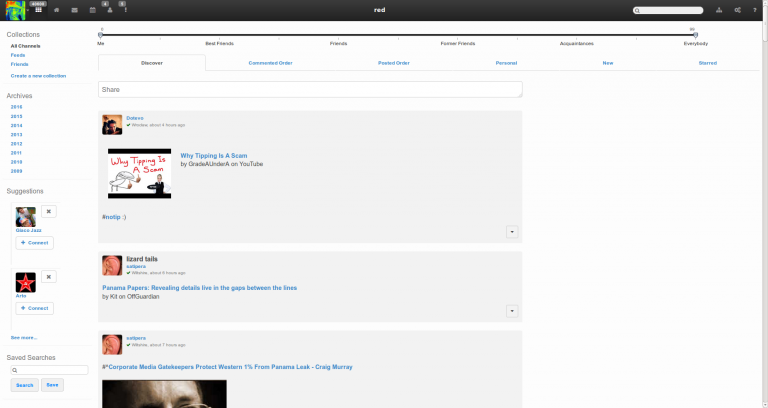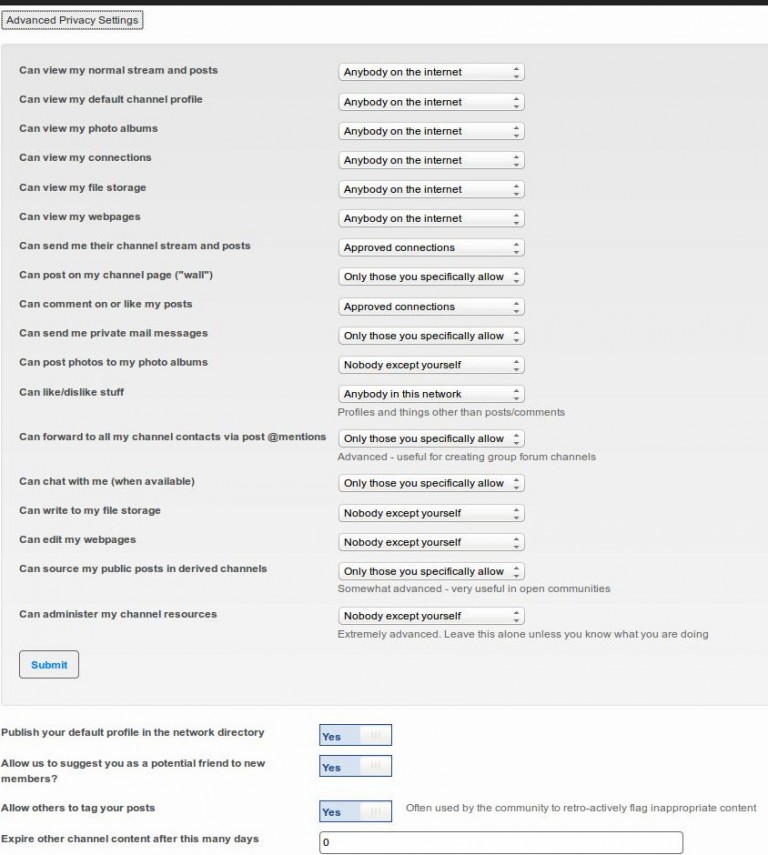Red Matrix – a decentralized social network with inscrutable design
The Red Matrix was a open-source decentralized social networking software that was developed primarily by an Australian known as Mike Macgirvin. I installed the software and set-up a instance on one of my servers because I was excited about the premise of a social network not controlled by a central entity. But I quickly found the design decisions hampered the usability of the software. Evidently the project has now been re-branded/forked as Hubzilla and the flaws I point out in this may or may not have been fixed. I am still able to review it because I’m running my own version of the software on my server and it still interacts with the Hubzilla project via the Zot protocol.
The Design Process
First off Red Matrix was designed as an open-source project that is continually upgraded, and a work in process. It was never touted as a fully working and finished release but was in perpetual alpha verging on being beta. At the same time enthusiastic people were joining and interacting with each other and working to make it better. If one had issues with the project, the creator Mike was and still is generally accessible to answer questions and help troubleshoot. The appeal of the software was the manifesto now off-line, that basically outlined the vision of a social network built not upon commercialization and data-mining but the community. One of the problems with this rather scatter-shot approach was there never appeared to be sufficient refinement of the product to make it usable out of the box. The project spurned the traditional software concept of the release cycle where developers would attempt to select a certain feature set and then make a stable release. Red Matrix was constantly changing and being continually updated. This process while dynamic would also make it difficult to provide proper documentation or refinement of the features that exist.
Privacy in Design
One of the selling points for Red Matrix was that it offered a level of control over your data that was otherwise unavailable to you on most mainstream social networks. The problem with the approach was the complexity of the privacy interface which made it impossible for one to understand the implications of the decisions they were making. For instance here is the privacy menu.
The default setting, “privacy when desired” (similar to social network permissions but with improved privacy) doesn’t exactly mean anything in and of itself. In order to see the actual implications of the privacy choices and what they mean, you will need to click on the Advanced Privacy Settings.
This selection choice is further compounded by another section known as “Automatic Permissions” (advanced).
There are quite a few problems with this set-up but the major one is that it presents the user with a tremendous amount of choices up front. Rather than making the choice for the user and hiding the option to modify it, they are instead required to make a number of choices or go even further done the line. Based upon the notion of Hick’s law this will increase the cognitive load of anyone attempting to set-up a profile. Additionally the paradox of choice means that people given a number of options will be less likely to think that they have chosen the right one later.
Another central principle of user interface design is that there is elegance in simplicity. Being open-source and put together by developers that were frustrated by the lack of control they had over their social network, Red Matrix opted for complexity and customization. While this might appeal to certain users who value the ability to refine every aspect of their profile, it could also cause confusion. When an interface reaches a certain level of complexity mistakes become almost unavoidable and when you are dealing with privacy and sharing of digital data the consequences can be catastrophic.
Usability Goals
So it is easy to compare the trade-offs the designers made when implementing the Red Matrix UI. For example, the software is rather effective in accomplishing a decentralized social network in that it allows people something akin to the experience of Facebook all while depending upon a centralized server. From a technical perspective this is quite the accomplishment. But working software is only one aspect of a social platform. The primary draw for any social platform is the ability to interact with other people, and other factors such as learnability are important in determining whether someone will take the time to adopt the technology.
The developers chose to prioritize utility over learnability and safety by providing a thousand choices to beginning users. While this may be seen as an escape from the tyranny of social platforms where users have very little control over how the software works it also requires a significant investment of time in learning the platform. This immediately limits the potential audience that might adopt this platform.
The Network Effect
The network effect, says that the value of a product or platform depends upon the number of other people using it. The real utility of social networks are inherently tied to the size of the network as you can only communicate with other users of the interrelated network. The lure of a platform such as such as Red Matrix is that it forms a decentralized network from a number of independent sites. At the same time this is not going to be a functional alternative to Facebook, Twitter, and others unless it has some clearly defined advantages over these platforms. Currently the audience appears to be limited to a few technically inclined individuals who for idealogical reasons have chosen to work on an open-source alternative to mainstream social networks. While this might work for people seeking to develop a social enclave independent of external control, it is unlikely to have a lot of lure for people who see a social network as a means to connect with their friends in general.
Hubzilla
After doing the initial analysis of the pre-existing Red Matrix install I decided to install Hubzilla in order to see what changes or improvements had been implemented over the last few years. The first question I have is about the branding in general and whether the name of Hubzilla is a hindrance in and of itself. Open-source projects have a tradition of choosing really absurd names that act kind of like in-jokes. GNU stands for Gnus Not UNIX, a self-referential acronym may have begun this tendency. Hubzilla, unfortunately is not abstract enough to be a blank slate but instead brings a lot of different connotations to the average user. Beyond the name though there have been some underlying improvements to the usability of the software.
First off the permissions have become more explicitly defined for the beginning user when they create a “channel”. The notion being that a channel can be a personal profile, page, forum or soapbox depending upon the choices that one makes about privacy vs. an underlying decision made by the software. Here is the replacement for the privacy choices screen used in Red Matrix.

This represents a dramatic improvement but is still probably too much choice to give to someone initially signing up for an account on your server. One improvement might be to allow the administrator of a site to make all users have a default privacy role and be unable to choose an alternative. This would make the rules of the platform understandable for people using it and this is a central requirement that builds trust in a site. Currently this feature is not available for anyone administrating a Hubzilla hub and so each user that signs up will be given the option of choosing between 10 different privacy options.
There have been a number of other improvements that are moves in the right direction but the software is still plagued by the complexity and overwhelming number of features. This sort of feature creep is all to prevalent in open-source software as there is little disincentive for a developer to code a new feature. All too often the developers are so familiar with the software that they don’t understand how it might be confusing or counter intuitive to a new user or less technically inclined person.
Recommendation
So overall while I still find the idea of a decentralized social network platform to be fascinating, it appears that Hubzilla is still too complicated for it to be competitive with Facebook for most people. Other than the allure of free and open-source software and the ability to participate in the development of the code and make choices it doesn’t offer a lot of improvements over Facebook. The primary place I could see this software being useful would be for people wanting to set-up a private social network for their pre-existing group. On the other hand the primary feature of Hubzilla, that it allows networking between sites would contradict the privacy notion. So it is hard to say that this would be ideal software to use for this purpose. It is possible that software like this could be utilized to interconnect people from a number of different organizations outside of Facebook. For instance it could be set-up where individual clubs of a national federation could have their own hub that was connected with other clubs. Each group would maintain control over their own instance but could benefit from the interconnection. This type of special interest focused usage of the software might make sense but it would also require some customization of the software. It appears while browsing the Hubzilla platform that the Pirate Party is utilizing the network for this purpose.



